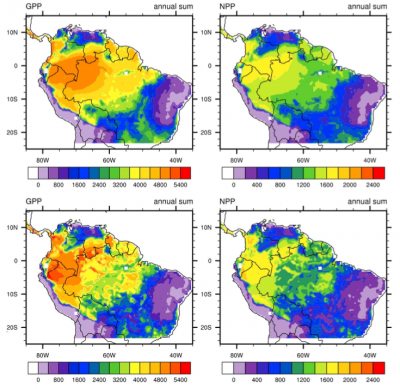Phosphorus Feedbacks Constraining Tropical Ecosystem Responses to Changes in Atmospheric CO2 and Climate
In this study, we investigated how P cycling dynamics might affect tropical ecosystem responses to changes in atmospheric CO2 and climate using a P-enabled land surface model. We demonstrated that the coupling of P dynamics reduces the simulated historical terrestrial C sink due to increasing atmospheric CO2 concentrations by about 26%.
Phosphorus (P) has been generally considered to be the most limiting nutrient in lowland tropical forests. Several recent field studies in the Amazonia have highlighted the importance of P in tropical forest productivity and function. Despite the importance of P in tropical carbon cycling, most Earth System Models don’t currently include P cycling and P limitation. Our work introduces this important biogeochemical cycle and examines consequences for Earth system feedbacks.
It is being increasingly recognized that carbon-nutrient interactions play important roles in regulating terrestrial carbon cycle responses to increasing CO2 in the atmosphere and climate change. Nitrogen-enabled models in previsous Earth system model intercomparisons showed that accounting for nitrogen greatly reduces the negative feedback between land ecosystems and atmospheric CO2. None of the CMIP5 models has considered P as a limiting nutrient, although P has been considered the most limiting nutrient in lowland tropical forests. In this study, we investigated the effects of P availability on carbon cycling in the Amazon region using a P-enabled land surface model. Model simulations demonstrates that CO2 fertilization effect in the Amazon region may be greatly overestimated if P cycling were not considered. Exploratory simulations highlighted the importance of considering the interactions between carbon, water, and nutrient cycling (both nitrogen and phosphorus) for the prediction of future carbon uptake in tropical ecosystems. Our simulations point to the need for (1) new observations on how elevated [CO2] affects phosphatase enzyme production and (2) more tropical leaf-scale measurements under different temperature/humidity conditions with different soil P availability.

